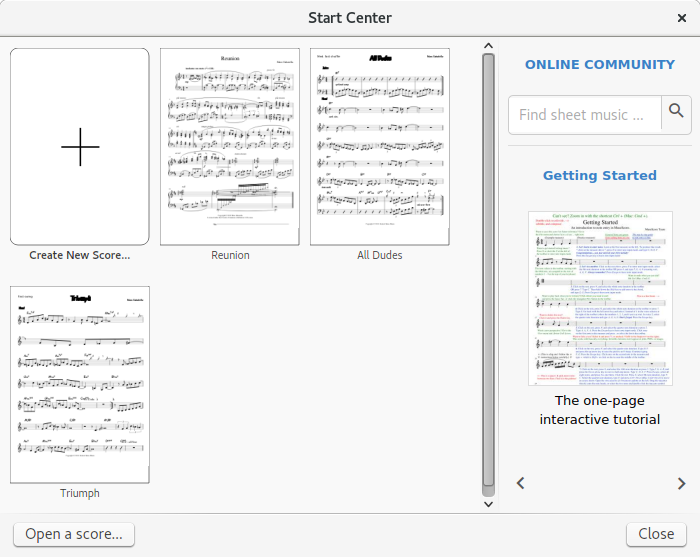
MuseScore

Create, playback, and print sheet music for free. MuseScore is cross-platform, multi-lingual, open source music notation software. It features an easy to use WYSIWYG editor with audio score playback for results that look and sound beautiful. It supports unlimited staves with up to four voices each, dynamics, articulations, lyrics, chords, lead sheet notation, import/export of MIDI and MusicXML, export to PDF and WAV, plus online score sharing.
MuseScore can upload scores directly to the score sharing site musescore.com. Program support is provided on musescore.org.
Features supported by MuseScore include:
- Unlimited score length
- Unlimited number of staves per system
- Up to four independent voices per staff
- Score creation wizard and templates
- Automatic part extraction and transposition
- Repeats, including segnos, codas, and measure repeats
- Dynamics, articulations, and other expression markings, with playback support for most
- Custom text markings
- Lyrics
- Chord symbols
- Jazz notation, including lead sheets, slash notation and a “handwritten” font for text
- Swing and shuffle playback
- Mixer for instrument levels and effects
- Percussion notation
- Early music notation
- Cross-staff beaming
- Import of graphics
- Custom key signatures
- Additive time signatures
- User-defined score styles
Most elements in MuseScore are laid out automatically but can also be positioned manually. The capabilities of MuseScore can be extended via plugins, and the growing repository on musescore.org contains many plugins submitted by users.
MuseScore includes a set of sounds that reproduce common instruments (as defined by General MIDI) without taking up a lot of disk space or memory, but you can also substitute any SoundFont you prefer for a wider variety of sounds or for more realism.
MuseScore can import and export MIDI and MusicXML files, and it can also import from Capella and several other programs. MuseScore can export to PDF, PNG, and other graphic formats, to WAV and other audio formats, or to Lilypond for an alternative layout and print option.
MuseScore Website MuseScore Bugtracker MuseScore FAQ MuseScore Help Donate Help translating MuseScore
Usage
MuseScore is available as an AppImage which means "one app = one file", which you can download and run on your Linux system while you don't need a package manager and nothing gets changed in your system. Awesome!
AppImages are single-file applications that run on most Linux distributions. Download an application, make it executable, and run! No need to install. No system libraries or system preferences are altered. Most AppImages run on recent versions of Arch Linux, CentOS, Debian, Fedora, openSUSE, Red Hat, Ubuntu, and other common desktop distributions.
Running MuseScore on Linux without installation
Unlike other applications, AppImages do not need to be installed before they can be used. However, they need to be marked as executable before they can be run. This is a Linux security feature.Behold! AppImages are usually not verified by others. Follow these instructions only if you trust the developer of the software. Use at your own risk!
Download the MuseScore AppImage and make it executable using your file manager or by entering the following commands in a terminal:
chmod +x ./*.AppImageThen double-click the AppImage in the file manager to open it.
Sandboxing MuseScore
If you want to restrict what MuseScore can do on your system, you can run the AppImage in a sandbox like Firejail. This is entirely optional and currently needs to be configured by the user.
Updating MuseScore
If you would like to update to a new version, simply download the new MuseScore AppImage.
The MuseScore AppImage also can be updated using AppImageUpdate. Using this tool, MuseScore can be updated by downloading only the portions of the AppImage that have actually changed since the last version.
Integrating AppImages into the system
If you would like to have the executable bit set automatically, and would like to see MuseScore and other AppImages integrated into the system (menus, icons, file type associations, etc.), then you may want to check the optional appimaged daemon.
Note for application authors
Thanks for distributing MuseScore in the AppImage format for all common Linux distributions. Great! Here are some ideas on how to make it even better.
Pro Tips for further enhancing the MuseScore AppImage
Thanks for shipping AppStream metainfo inside your AppImage. Please open a pull request on https://github.com/AppImage/appimage.github.io/blob/master/data/MuseScore if you have changed it and would like to see this page updated accordingly.
